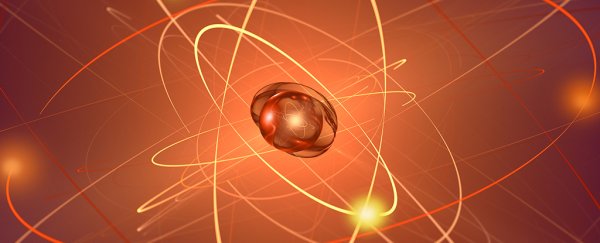In what was once thought to be an impossible task, for the first time physicists have put a figure on the pressure inside a proton - and it's more impressive than we could have imagined.
By shooting protons with high-energy electrons, researchers have measured the push and pull of the proton's trio of quarks, providing valuable insights into one of the Universe's most stable building blocks.
Physicist Latifa Elouadrhiri from the Thomas Jefferson National Accelerator Facility compares our previous understanding of the proton's structure to that of a human heart. Listening to its beat can only tell you so much about how it works.
"We have the medical 3D imaging technology that now allows the doctors to learn more in a non-invasive manner the structure of the heart," Elouadrhiri told Nature reporter Lizzie Gibney.
"And this is what we want to do with the new generation of experiments."
We've understood for some time now that protons are made of three quarks – two of an 'up' variety, one described as 'down' – bound together by something called the strong nuclear force.
Beyond that, the proton's internal structure has long been a mystery. Its quarks clearly hold together tightly, but there also has to be some sort of repulsion preventing them from collapsing into a point.
To measure how tightly these pieces come together, the researchers combined two different theoretical frameworks, one of which was considered practically impossible to implement directly.
The energy and momentum of a proton's internal parts are encoded in what are called gravitational form factors.
Gravity is such an insanely weak force it's hardly given any thought in particle physics, not when there are far stronger forces at work.
But deep inside the proton a gravitational field can be affected by a particle's energy and momentum.
It's been one of those 'nice idea in theory' things, unfortunately. A 1966 paper by American physicist Heinz Pagels described the process while also ruling out its practical application thanks to gravity's extreme weakness.
What Pagels didn't anticipate was the development of a theoretical framework that connected behaviours of the electromagnetic force to gravitational form factors.
In other words, it was later discovered that electrons could substitute for a gravitational probe.
"This is the beauty of it. You have this map that you think you will never get," says Elouadrhiri.
"But here we are, filling it in with this electromagnetic probe."
The key was to use Compton scattering, which describes the interaction between photons of light and a charged particle, such as an electron.
In this case, they ramped up the acceleration of an electron to narrow its wavelength enough to penetrate a proton.
They then watched for the scattering of photons that were produced, combining their details with information on the proton and the accelerated electron to determine how the quarks reacted to the strike.
This scattering provided a map of energy and momentum to describe an extreme outward pressure in the centre of the proton preventing it from collapsing.
Meeting this push was an equal pressure keeping the quarks together.
It turns out this quark hug equals 100 decillion Pascal. That's a one followed by 35 zeroes.
Imagine a neutron star, where matter is squeezed tight enough to squeeze a mountain into a mound small enough to fit into a teaspoon. The team says that this quark pressure is ten times greater, making the core of a proton a wildly intense space.
The next step for the team is to continue to use this process to build further understanding of the proton's internal mechanics, calculating its forces and eventually building a picture of how its quarks move around.
Knowing more about a proton's guts could tell us more about whether protons decay.
Right now they seem stable enough to outlast the Universe (and then some), but determining how and when they break down would provide valuable clues on some of the fundamental features of the cosmos.
This research was published in Nature.
